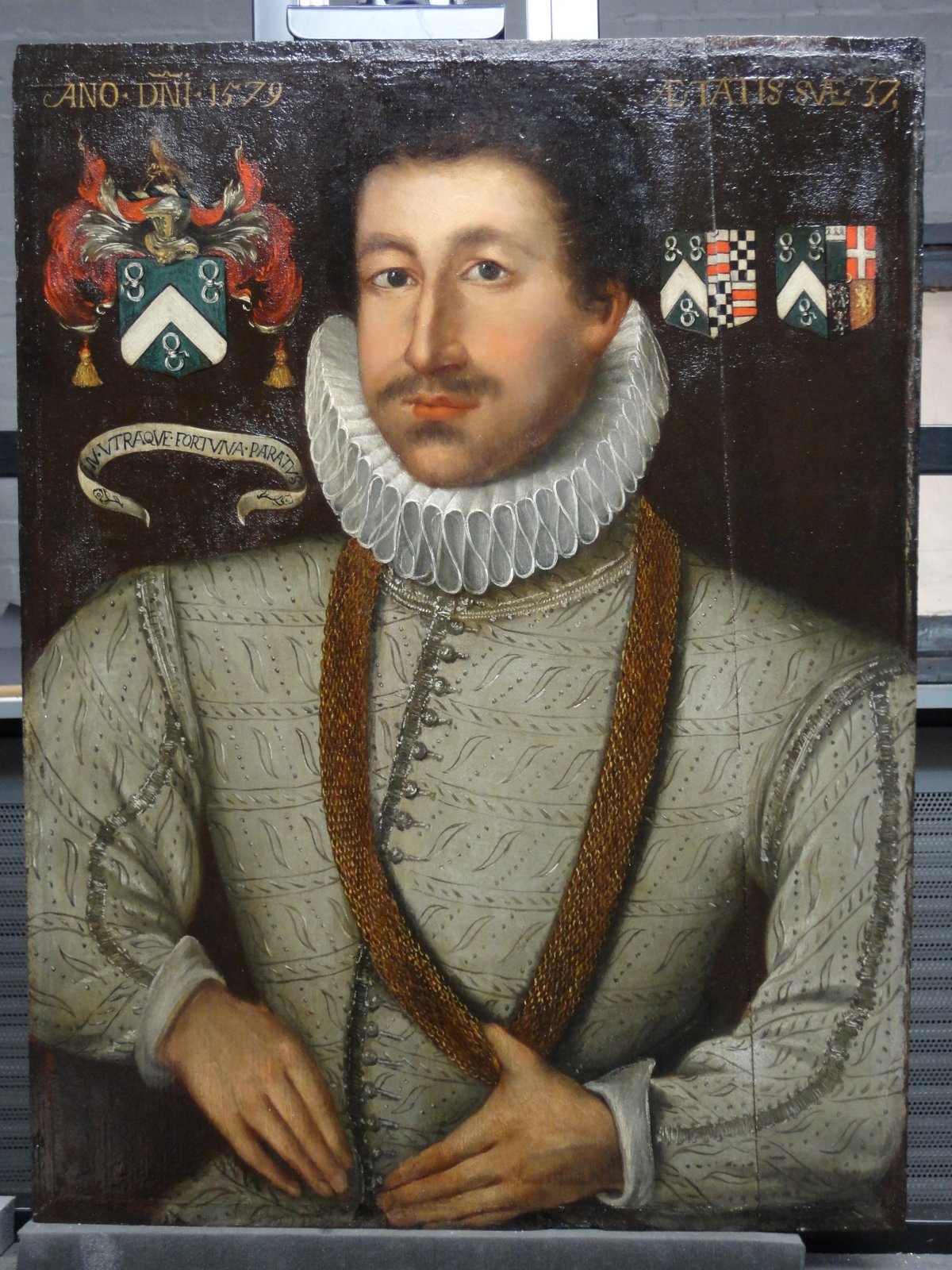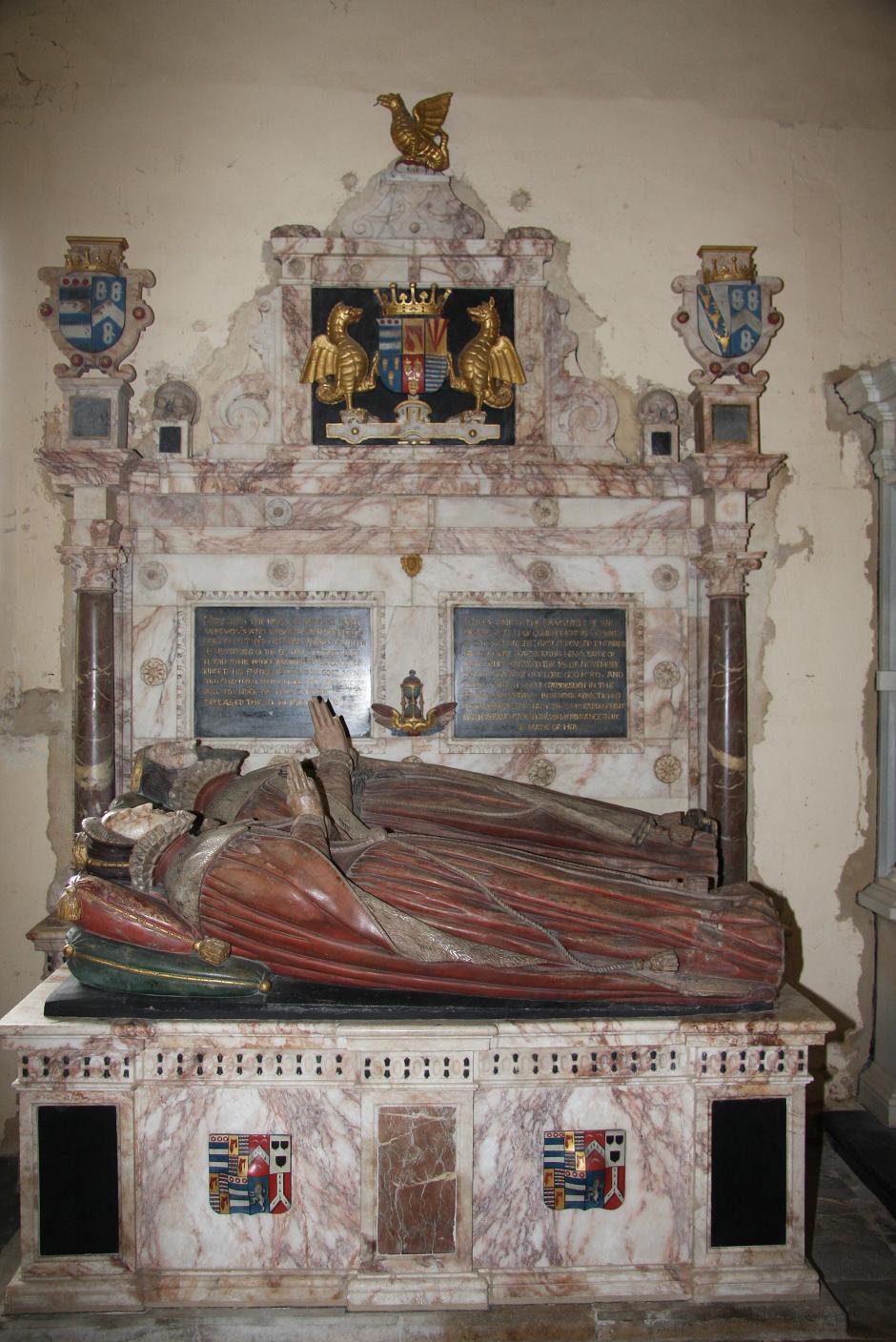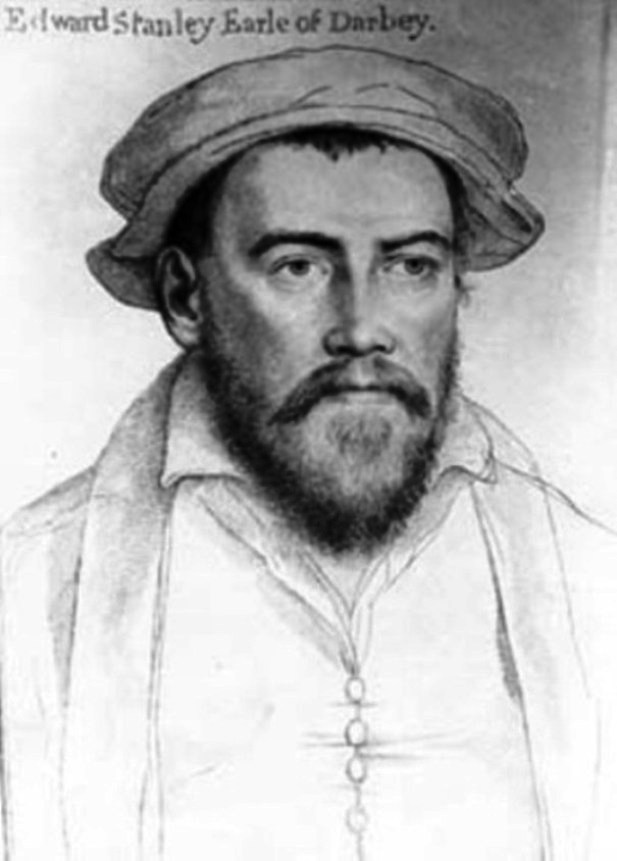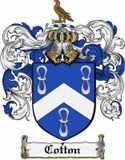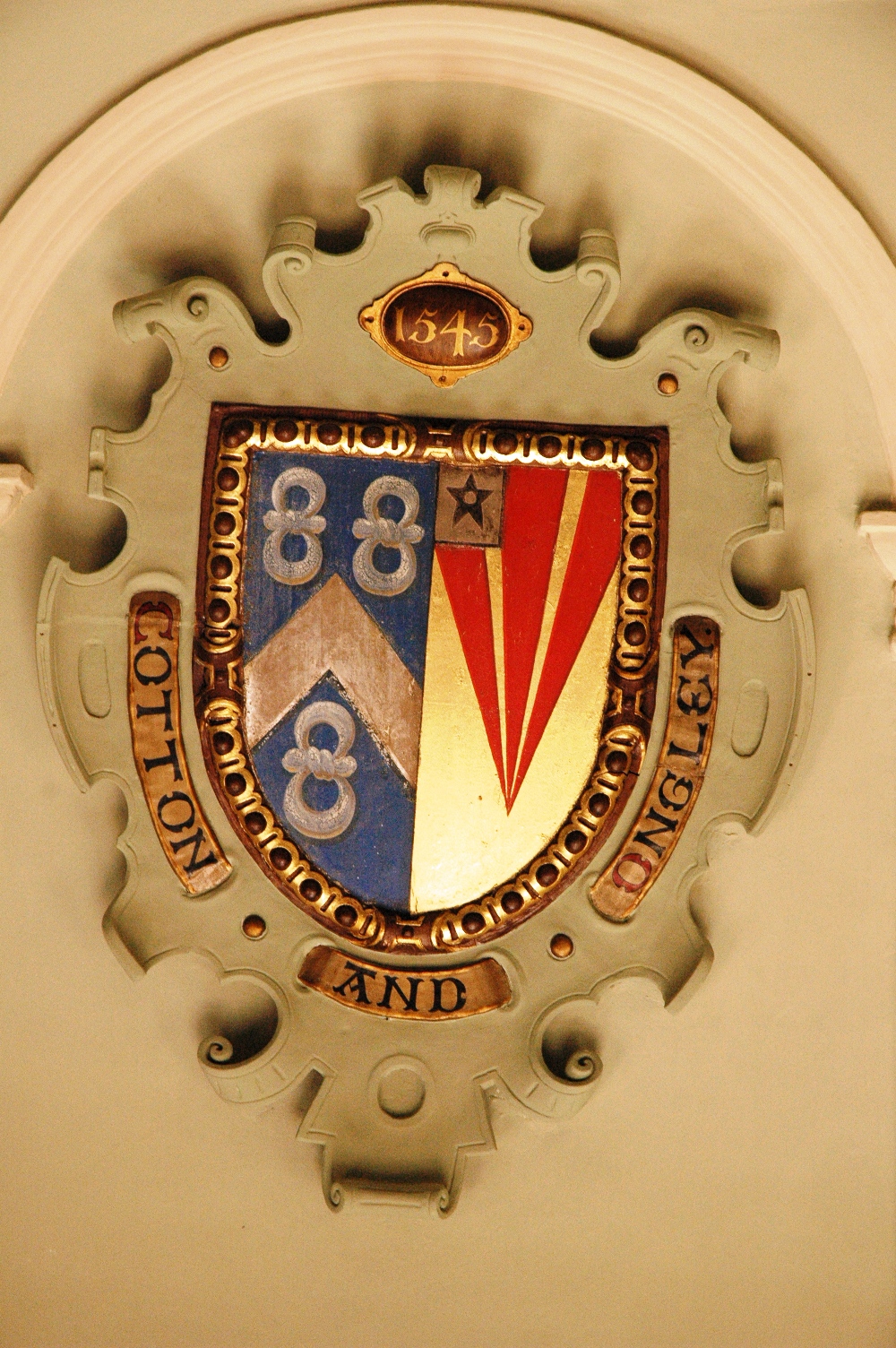Sir George Cotton and Mary Onley
Sir George Cotton was born about 1505 in Coton, Shropshire, England to John Cotton and Cecily Mainwaring. Sir George married Mary Onley. Mary was the daughter of John Onley and Jane Pontesbury.
Sir George was the Sheriff of Denbighshire and an esquire to the body of Henry VIII (in other words, a personal attendant and courtier). The position of esquire of the body is described as follows: "The office of esquire of the body, was of a very honourable nature. It is thus described in the household book of Edward the Fourth, Esquiers for the body, four, noble of condition, whereof always two be attendaunt upon the king's person to array and unarray hym, to watche day and nyght to dress hym in his clothes, and they be callers to the chaumberlayn if any thing lak for his person, or 'plesaunce; theyre busines is in many secrets, some sitting in the king's chaumber, some in the hall with persones of like service, which is called knyghts service, taking every of them for his lyvery, at night, a chete loffe, one quart wyne, &c.'" (British History Online, entry for Carshalton, http://www.british-history.ac.uk/london-environs/vol1/pp122-136, visited 30 May 2017.)
King Henry VIII granted Sir George the estate at Combermere in Shropshire, a former abbey, 3 February 1541/2 (obtained the site and demesne of Combermere Abbey and 2/3 of Newhall Manor upon surrendering a two-year-old grant). He was also knighted by the king in or before 1542. He also was granted the manor of Wilkesley in Cheshire 3 April 1542 and the manor of Pulton in Cheshire 19 August 1543.
Sir George died 25 March 1545 at Combermere, Shropshire, England. Mary died 14 March 1559/60 at Combermere, Shropshire, England.
Sir George and Mary’s children are:
- Sir Richard Cotton, born about 1539, married 1) Mary Mainwaring (dau. of Sir Arthur Mainwaring and Margaret Mainwaring of Ightfield, Shropshire, England) 6 Jan 1559/60 in Combermere, Shropshire, England, 2) Jane Seyliard (dau. of William and Joan (Todd) Seyliard) 14 Jun 1578 in St. Olave Jewry, London, Middlesex, England and 3) Philippa — (m. 1) John Dormer of Buckinghamshire, d. in the parish of St. Michael, Coventry, Warwickshire, England, will dated 30 May 1625 and probated 18 Aug 1631), built the manor house at Combermere in 1563, lived for the last few years of his life at Stoke, Warwickshire, England, died intestate 14 June 1602 in Stoke, Warwickshire, England.
- Mary Cotton, married 1) Edward Stanley, 3rd Earl of Derby (son of Thomas Stanley, Earl of Derby, and Anne Hastings, married 1) Catherine Howard, 2) Dorothy Howard and 3) Margaret Barlow before marrying Mary, ward of Henry VIII, Knight of the Bath 1533, among those who subscribed to the declaration to the Pope regarding the divorce of the King and Queen, took part in suppressing rebellions in 1536 and 1537, accompanied the Duke of Norfolk on his raid into Scotland in 1542, Order of the Garter 1547, among the parties to the articles of peace with the Scottish and French in 1550, Lord High Steward of England and a member of the Privy Council (retained during Elizabeth's reign) under Queen Mary, a commissioner for the trial of Lady Jane Grey and others, frequently took part in the proceedings against heretics during Mary's reign, one of those summoned to meet Elizabeth I on her entry into London, chamberlain of Chester in 1559, d. 24 Oct 1572 at Lathom House, Lathom, Lancashire, England, bur. 4 Dec 1572) and 2) Henry Grey, 6th Earl of Kent (b. 1541 to Henry de Grey, was also Lord Lieutenant of Bedfordshire and 9th Baron Grey of Ruthyn, knighted 1570, member of the Queen's Household, one of the commissioners that passed the sentence of death on Mary Queen of Scots and tasked to break the news to her along with the Earl of Shrewsbury, d. 31 Jan 1614/5, bur. at the de Grey Mausoleum, Flitton), died 16 Nov 1580, buried at the de Grey Mausoleum, St. John the Baptist, Flitton, Bedford, England.
- Dorothy Cotton, married Edward Torbock (of Torbock, Lancashire, England), alive 6 Jun 1608 (widowed at the time).
Note: Some genealogies list two more daughters, Winifred and Elizabeth, but Boyer thought that they were likely mixed up from the next generation (Sir Richard's children).
Sources:
Records related to Sir George and Mary (Onley) Cotton but not copied below due to copyright considerations:
- Stewart-Brown, R. (ed.), Cheshire Inquisitions Post Mortem: Stuart Period, 1603-1660,Vol. I (A-D), The Record Society of Lancashire and Cheshire, 1934, p. 146.
- Combermere Abbey site, http://www.combermere-restoration.co.uk/, visited 30 May 2017.
- London Metropolitan Archives, St Olave Jewry, Composite register: baptisms 1558 - 1660, marriages 1558/9 - 1653/4, burials 1558 - 1672, P69/OLA2/A/002/MS04400, Item 00. Ancestry.com. London, England, Church of England Baptisms, Marriages and Burials, 1538-1812 [database on-line]. Provo, UT, USA: Ancestry.com Operations, Inc., 2010. Original data: Church of England Parish Registers, 1538-1812. London, England: London Metropolitan Archives.
- "Edward Stanley," Tudor Place, http://www.tudorplace.com.ar/Bios/EdwardStanley(3EDerby).htm, visited 30 May 2017.
- Bedfordshire Parish Churches, http://bedfordshireparishchurches.co.uk/wp/flitton-mausoleum/, visited 31 May 2017.
- Boyer, Carl, Medieval English Ancestors of Robert Abell, Santa Clarita, CA: C. Boyer, 2001.
Portraits and Other Images
Portraits from Combermere Abbey site (http://www.combermere-restoration.co.uk/1500s-to-present-day/):
Description: "Richard Cotton; the portrait inset into the fire surround in The Library"
Tomb of Henry Grey, Earl of Kent and his wife, Mary (photo credit: julia&keld, findagrave.com):
Close-ups of the effigies' faces: http://bedfordshireparishchurches.co.uk/wp/flitton-mausoleum/
Edward Stanley, Earl of Derby:
Cotton Arms:
Cotton and Onley (Ongley) arms joined (from http://www.combermere-restoration.co.uk/1500s-to-present-day/):
Church Records
Name: Jane Suliard
Marriage Date: 19 Jun 1578
Parish: St Olave, Old Jewry
County: London
Borough: City of London
Spouse: Richard Cotton
Record Type: Marriage
Register Type: Parish Register
Source: London Metropolitan Archives, St Olave Jewry, Composite register: baptisms 1558 - 1660, marriages 1558/9 - 1653/4, burials 1558 - 1672, P69/OLA2/A/002/MS04400, Item 00. Ancestry.com. London, England, Church of England Baptisms, Marriages and Burials, 1538-1812 [database on-line]. Provo, UT, USA: Ancestry.com Operations, Inc., 2010. Original data: Church of England Parish Registers, 1538-1812. London, England: London Metropolitan Archives.
Inquisition Post Mortem
(File 87. No. 14).
They say the said Richard Cotton the day he died was seised in fee of a capital mess. in Cumbermeyre & of a water mill, 1000 a. of land, 500 a. of meadow, 1000 a. of pasture, 200 a. of moor, 200 a. of wood & 200 a. of land covered with water in Combermeyre, Wrenbury & Aldelem.
He was also seised in fee tail, to him & his male issue, of the manor of Wilkesley.
The said capital mess. & lands are held of the King & at the time of Richard's death of Queen Elizabeth in chief, by 10th part of a knight's fee & rent of 53s. 4d. a year & worth yearly (clear) £12.
The manor of Wilkesley held in like manner, by 20th part of a knight's fee & yearly rent of £4 12s. 8d. & worth yearly (clear), £56.
The said Richard died 15 June 44 Elizabeth [1602] & George Cotton, esq. is his son & next heir & now aged 40 years & more & since his father's death has occupied the said premises.
Source: Stewart-Brown, R. (ed.), Cheshire Inquisitions Post Mortem: Stuart Period, 1603-1660,Vol. I (A-D), The Record Society of Lancashire and Cheshire, 1934, p. 146.
Biography
Edward was about thirteen years old when he succeeded to his father's title and estates, and the King took responsibility for his upbringing until he came of age, his affairs were managed by commissioners, of whom Cardinal Wolsey was one, the governor and other civil authorities in Man being continued in office until he attained his majority. In 1528, he attended the Cardinal on an embassy to France; and, in 1530, he was one of the peers who subscribed the declaration to Pope Clement VII. That, if he refused to confirm the divorce of Queen Catalina, his supremacy in England would be endangered. In 1530, Thomas Howard, Duke of Norfolk found himself in trouble over what he must have considered a mere formality, the requirement for the King's assent to all marriages within the peerage. Norfolk arranged for his eldest daughter, Catherine, to wed Edward Stanley, whose family had long held considerable influence in the north of the realm. Henry choose to view the arrangement as an abduction of the twenty year old Derby, who was still legally a minor. On 21 Feb 1530, Norfolk was forced to sue for pardon and post a bond with the King, but was still allowed to carry the marriage to conclusion. Catherine Howard was at least twenty two years old when a few weeks later, on 16 Mar 1530, died suddenly of the plague. Anxious not to loose this alliance the Duke arranged for his half-sister, Dorothy to become Derby's second wife. Norfolk considered the Derby marriage to be so important that he 'had no had a sister to offer he would have proposed his oher daughter...' who has been promised to the King bastard son, the Duke of Richmond. In 1532, he issued a commission to inquire into the exactions which the people of Man alleged were practised by the clergy under the guise of mortuaries or corpse-presents. In the same year he was present with Henry VIII at his interview with Francois I at Boulogne, and, in 1533, he was made a Knight of the Bath. He took a prominent part in suppressing the northern rebellion in 1536 and 1537. In 1542, he accompanied the Duke of Norfolk, on his raid into Scotland. On the accession of Edward VI in 1547, he received the Garter; and, in 1550, he was one of the peers who were parties to the articles of peace with the Scottish and French. In Jun 1551, it was reported that he had been commanded to renounce his title to the Isle of Man and that he had refused, being prepared to resist by force. It is not known what truth there is in this, but, if any action was intended to have been taken against him, it was probably on account of his strong opposition to all religious changes. For the same reason, he would have been in high favour on the accession of Queen Mary. He was then appointed lord High Steward of England and a member of the Privy Council. He was a commissioner for the trial of Lady Jane Grey and others, and, during Mary's reign, he frequently took part in the proceedings against heretics. He contrived to secure the favourable opinion of Queen Elizabeth, being one of those summoned to meet her on her entry into London. She retained him as a privy councillor and, in 1559, she appointed him chamberlain of Chester. In 1561, he appointed five commissioners to examine into and establish regulations for preventing the "great Waste that hathe been made in the Castle, and in the Peele, in bread, fuell, candles, and other things", and to fix the fees of certain officers and the amount of fines and amercements due to the Lord of the Isle for infringement of the laws. The Earl died 24 Oct 1572, at Lathom House, and was buried 4 Dec 1572. He was suceeded by his eldest son, Henry, as fourth Earl of Derby.
Source: "Edward Stanley," Tudor Place, http://www.tudorplace.com.ar/Bios/EdwardStanley(3EDerby).htm, visited 30 May 2017.
Henry de Grey 6th Earl of Kent
The builder of the initial mausoleum was Henry de Grey the 6th Earl of Kent who died in 1615. He was the second son of Henry de Grey who in turn was the son of Henry de Grey the 4th Earl of Kent. It is worth noting that Henry does seem a popular name in the de Grey family!
The 6th Earl succeeded to the title on the death of his brother Reynold, the 5th Earl, in 1573. He also held the title of Lord Lieutenant of Bedfordshire and 9th Baron Grey of Ruthyn. The 6th Earl was primarily responsible for restoring the fortunes of the de Grey family after an earlier Earl had lost most of the estates through extravagant living and gambling.
Born in 1541, he was knighted in 1570 and became a member of the Queen’s Household. He was one of the commissioners who passed the death sentence on Mary Queen of Scots in 1587. Indeed, along with the Earl of Shrewsbury he was tasked with visiting Mary to break the news of her sentence. Along with the residence at Wrest (an earlier building rather than the current house) he owned properties in Blunham in Bedfordshire, Kew and a house in the Barbican in London.
Henry’s will stated that the monument was to celebrate both this achievement and to act as a reminder to his descendants about the consequences of excessive living. The 6th Earl was married to Mary Cotton (d. 1580) who was the daughter of Sir George Cotton of Combermere in Cheshire and widow of the 3rd Earl of Derby but they had no children.
The richly coloured chest tomb monument is of multi-coloured alabaster and is the earliest monument in the mausoleum.
It depicts the 6th Earl and his wife in traditional poses of the Jacobean style, formally dressed and in prayer awaiting resurrection.
The painted effigies are lifelike but very stiff in appearance.
Above are heraldic symbols including a golden wyvern, an image associated with the de Grey family. On either side of the wyverns are skulls which are believed to be genuine.
The crest at the top of the monument was probably added later and between the two wyverns shows the de Grey coat of arms in the top left of the six. The other arms on the shield reflect alliances by marriage including the Valence (top centre) and Hastings (bottom right) families.
Source: Bedfordshire Parish Churches, http://bedfordshireparishchurches.co.uk/wp/flitton-mausoleum/, visited 31 May 2017.
